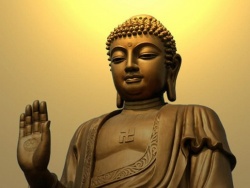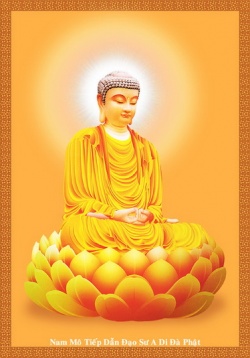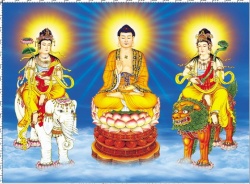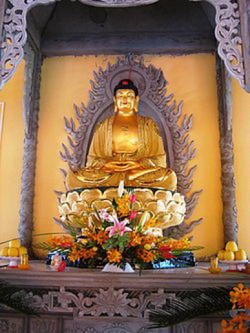The Triple Gem
The Triple Gem
In Buddhism, The Triple Gem refers to:
THE BUDDHA
THE DHAMMA
THE SANGHA
WHO IS THE BUDDHA? He is the Blessed, Holy and Fully Enlightened One.
WHO IS THE BUDDHA? He is the Teacher of the Dhamma, the Truth that will lead all beings to Perfect Happiness and Bliss – NIBBANA
WHO IS THE BUDDHA? He is the incomparable Leader and Teacher of gods and men.
WHO IS THE BUDDHA? He is the Fully Awakened One, the Knower of the worlds.
WHO IS THE BUDDHA? He is the Blessed One endowed with clear vision and virtuous conduct.
WHAT IS THE DHAMMA? It is The TRUTH, The Way Things Are.
WHAT IS THE DHAMMA? It refers to the Teachings Of The Buddha.
WHAT IS THE DHAMMA? It is NATURE and The Universal Laws.
Dhamma can refer to Good or Righteous Conduct.
By learning, understanding and practicing the Dhamma, we can
End our problems
Be happy and peaceful
Attain the Bliss of Nibbana
WHAT IS THE SANGHA? It is the Holy Order of monks and nuns who follow the Buddha-Dhamma Path.
The Sangha can also refer to the spiritual people who practice and teach true Dhamma and guide us in the correct spiritual path to reach Nibbana.
The Sangha may also refer to the spiritual community that understands and practices the Dhamma to gain wisdom and liberation.
The End True Refuge in The Triple Gem will lead one to Happiness, Peace, Bliss and Freedom Of The Mind. With Metta, Bro. Oh Teik Bin
2. What’s the Triple Gem? Buddha (covered in Lesson 4) Dhamma = Buddha’s teachings Sangha = Community of monks,nuns, lay devotees - upasaka & upasika)
3. Taking Refuge in the Triple Gem It is an unbroken age-old tradition in Buddhist countries for a Buddhist to take his refuges in the Triple Gem and to observe the Five Precepts.
4. Buddham saranam gacchãmi Dhammam saranam gacchãmi Sangham saranam gacchãmi Dutiyampi Buddham saranam gacchãmi Dutiyampi Dhammam saranam gacchãmi Dutiyampi Sangham saranam gacchãmi Tatiyampi Buddham saranam gacchãmi Tatiyampi Dhammam saranam gacchãmi Tatiyampi Sangham saranam gacchãmi I go to the Buddha for refuge. I go to the Dhamma for refuge. I go to the Sangha for refuge.
For the second time I go to the Buddha for refuge. For the second time I go to the Dhamma for refuge. For the second time I go to the Sangha for refuge. For the third time I go to the Buddha for refuge. For the third time I go to the Dhamma for refuge. For the third time I go to the Sangha for refuge Taking Refuge
5. Pãnãti-pãtã veramani sikkhã padam samãdiyãmi Adinnã-dãnã veramani sikkhã padam samãdiyãmi Kãmesu micchã-cãrã veramani sikkhã padam samãdiyãmi Musãvãdã veramani sikkhã padam samãdiyãmi Surã meraya-majja-pamã-datthãnã veramani sikkhã padam samãdiyãmi I take the precept to abstain from destroying living beings. I take the precept to abstain from taking things not given. I take the precept to abstain from sexual misconduct. I take the precept to abstain from false speech. I take the precept to abstain from taking anything that causes intoxication or heedlessness. Observing Five Precepts
6. The Tipitaka (3 Baskets) Profound philosophy and metaphysics of the Buddha’s teachings (Buddhist psychology). Abhidhamma Pitaka Disciplinary code for the Order of monks and nuns. Vinaya Pitaka Discourses, sermons given by the Buddha and some of his senior disciples. Sutta Purpose Title
7. The Dhamma can answer the many questions posed by science. Albert Einstein once said that if there is one religion that would cope with modern scientific needs it would be Buddhism.
8. Why? It is because Buddhism is free from dogma. The Buddha had always stated that an individual should only accept something after thinking rationally and testing it with his reasoning and experiences. The Dhamma can answer many questions posed by science.
9. The Dhamma can answer many questions posed by science. Why? Many scientific discoveries are in line with the teachings of the Buddha. Examples: Einstein’s General Theory of Relativity Gravity The Space-Time concept Splitting of the atom by Berkeley Doctrine of Change advocated by Bergson
10. The Dhamma can answer many questions posed by science. Other examples: Advocacy by Prof. William James that the mind is a stream of consciousness. Assertion by Spinoza that all existence is transitory. Presentation by Schopenhauer about the truth of suffering and its cause. Why? Many scientific discoveries are in line with the teachings of the Buddha.
11. The Dhamma can answer many questions posed by science. Some of our present-day scientific philosophers are all unconsciously making it easier for the modern man to understand the concepts of Buddhism. These scientific discoveries are basically expounded by the Buddha through His doctrines of change (Anicca), sorrow (Dukkha) and no soul (Anatta) some 2,500 year ago.
12. Characteristics of Life All living beings, without exceptions, are subject to these characteristics. They are the universal laws of the world and are scientific in all their aspects. Characteristics of Life Impermanence (Anicca) Sorrow (Dukkha) No self (Anatta)
13. Characteristics of Life What is Anicca (Change or Impermanence)? Nothing can last forever. Even the highest mountain will one day be worn away.
14. Characteristics of Life What is Anicca (Change or Impermanence)? Our likes and dislikes change. Happiness is replaced by sadness. Sadness is replaced by happiness.
15. Characteristics of Life Anicca applies to everything in the Universe.
16. Characteristics of Life What is Dukkha (Sorrow)? Happiness is never permanent. Joy slips through our fingers and fades away even as we experience it. Man can endure the passing of his happiness only because he expects to gain it once more. If that expectation does not materialise, he sinks into despair. On the whole, the suffering (Dukkha) outweighs the happiness.
17. Characteristics of Life Is this concept of Dukkha pessimistic? Buddhism states the actual facts about life and there is a lot of suffering in life. However, the Buddha showed a way to end the suffering by following the Eightfold Path. It is hence not pessimistic as it provides a solution to end the suffering.
18. Characteristics of Life What is Anatta (no self)? Anatta is a difficult doctrine to understand. One can only understand it completely after achieving the first stage of sainthood (Sotapanna) .
19. Roles of the Sangha The Sangha members devote their lives not only to their own spiritual and intellectual, but also to the service of others. This is how in the course of history, the Buddhist monastery became not only a spiritual centre, but also a centre of learning and cultural aspect of life. Buddhist monks have always had it as one of their functions to teach the Dhamma to lay people.




